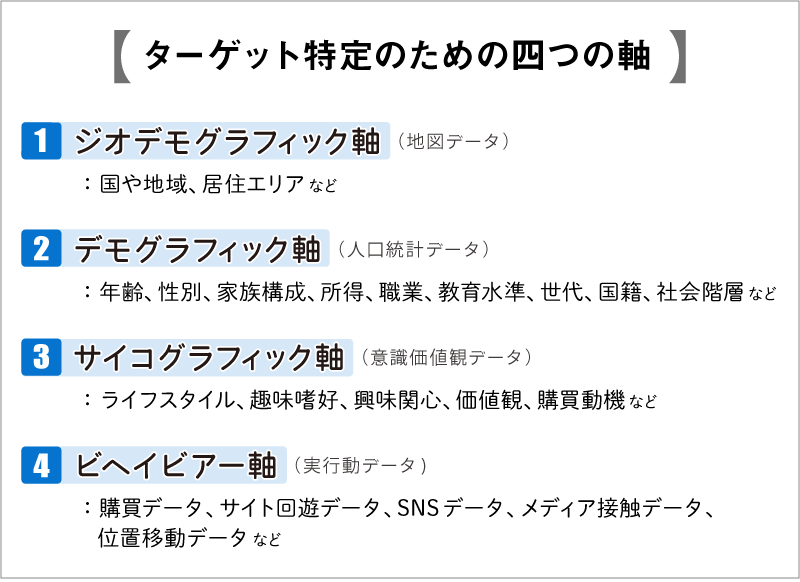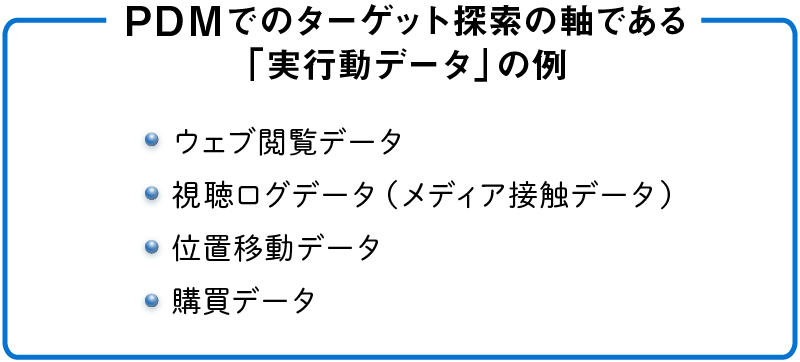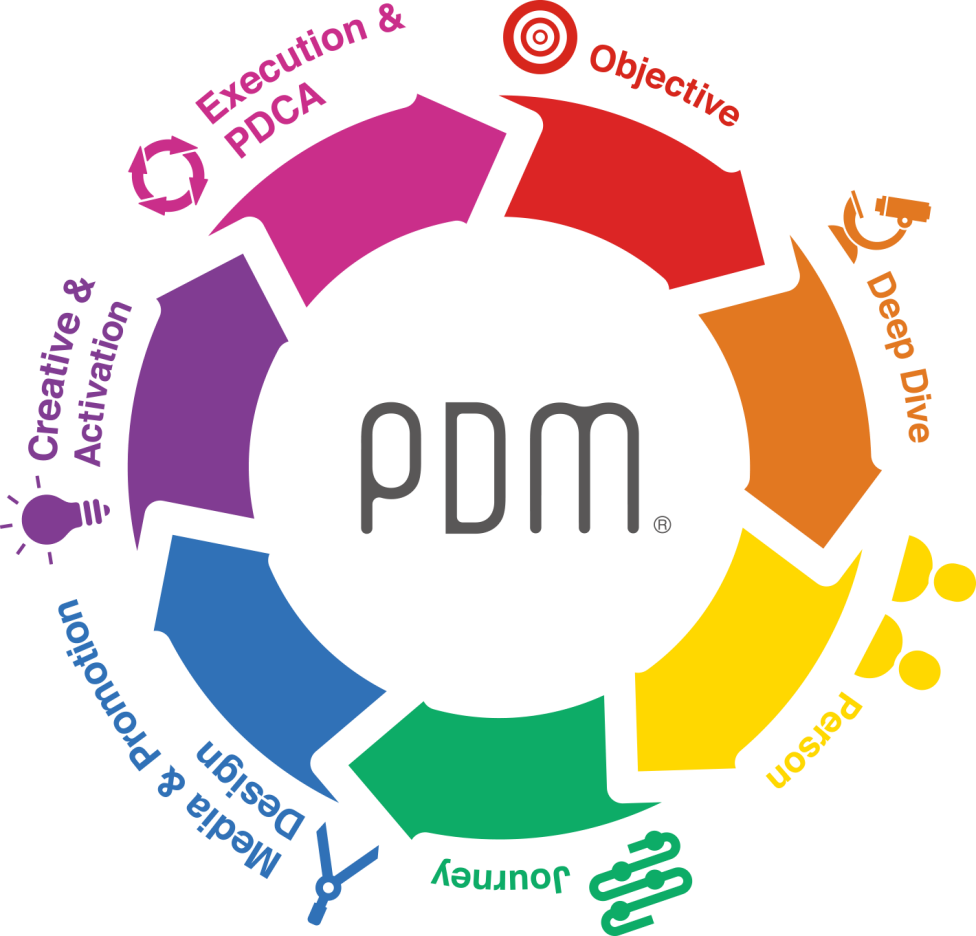Note: This website was automatically translated, so some terms or nuances may not be completely accurate.
Reverse-engineer thoroughly! Three ironclad rules for PDM target setting that become your blueprint for achieving goals

This series introduces the concept of People-Driven Marketing (PDM). This installment's theme is "Person" (Target Setting and Profiling).

In PDM, which weaves a story from the starting point of "people" to achieving business goals, it is crucial to capture the target customer profile with high resolution. The key methods are "working backwards from KGI/KPI" and "exploring the actual volume of the target using behavioral data."
*Note: PDM also includes a "DeepDive" phase for observing consumer behavior. This involves detailed analysis of the latest market trends and movements from the perspective of consumer awareness and actions, but we will omit it this time.
<Table of Contents>
▼ ~Ako's Story: Person Edition~
▼Target Setting: 3 Golden Rules!
Rule 1: Work backward to determine "who" needs to buy "how much" to achieve your KGI
Rule 2. Set multiple targets
Rule 3. Set targets based on "actual action data"
▼What target audience was calculated from "10% annual sales growth"!?
~Ako's Story: Person Edition~
Sports People, a large sporting goods store, has recently seen declining sales. Ako, a six-year employee entrusted with overall store manager support, set a KGI of "10% sales increase in one year" and shared it with all employees.
Sports People's annual sales are approximately 300 million yen, so a 10% increase means an annual sales boost of 30 million yen, requiring an average monthly increase of 2.5 million yen.
"To hit the target, should we focus on acquiring new customers... or no, should we make upselling and cross-selling to existing customers our core strategy?"
Ako began wondering which customer segment to target to hit her target figures. Even with a concrete KGI set, if the target audience remains vague, it's impossible to even estimate whether the goal is achievable.
"Up until now, we've roughly targeted 'sports and outdoor-loving men in their 20s to 40s,' but there should really be a much wider variety of customers out there."
Based on awareness data from past surveys, Ako tried working on customer segmentation. However, many of the segments that emerged were similar, and she couldn't even be sure such segments truly existed. How can she concretely envision the "target audience for achieving the KGI"?
Three Ironclad Rules for Target Setting!
This is Kaizuka from the Integrated Solution Development Office. Today, I'll discuss target identification and target insight analysis—the fundamentals of PDM.
Last time, in "Objective," we introduced the concept of "KGI and KPI for achieving business goals." This time, we explore how to identify the "target customer segments" needed to achieve those KGI and KPI.
To get right to it, target setting in PDM primarily consists of the following three "ironclad rules":
Iron Rule 1: Work backward to determine "who" needs to buy "how much" to achieve the KGI
Always estimate the target market size in "actual numbers." Based on the conversion rate calculated during the funnel design phase ( refer to the previous article ), set a target that seems sufficiently achievable for KGI attainment.
Rule 2: Set multiple targets.
In today's approach, where people's preferences and media touchpoints are diversifying, set multiple targets and design different, appropriate communications for each segment.
Rule 3: Define Targets Using "Actual Action Data"
Deriving targets based on "actual behavioral data"—such as purchase data, website browsing data, and media exposure data—enables the extraction of targets that are both approachable and easier to optimize individually.
Let's examine specific methods below.
Rule #1: Work backward to determine "who" needs to buy "how much" to achieve the KGI
No matter how complex consumer purchasing behavior becomes or how much ad technology evolves, a company's business objective remains "increasing sales." Ms. Ako at the beginning also set a goal of "10% sales growth."
Sales can be broken down into "who buys (new/existing customers)" and "how much they buy (quantity × price × frequency)." Ultimately, the key lies in how to discover and identify the "people" most likely to purchase your company's products or services.

Once you identify "who"—that is, the target audience to approach—the methods for selling your products or services (the media used to reach them, the content and tone of the information, timing, location, etc.) also become clear.
To achieve the KGI, we proceed with "backward-planning targeting" from the perspective of what kind of consumers with what needs we need to convert into customers and to what extent.
This time, let's set the target to achieve a 10% annual sales increase for "Sports People." The following perspectives are essential during exploration.
Figure 2
Rule 2: Set Multiple Targets
Traditional mass advertising campaigns often focused on "one target, one message," primarily based on TV commercials. PDM recommends setting around three targets based on differences in media exposure, product consideration methods, and website browsing tendencies to address the diversifying preferences and media/information acquisition behaviors of consumers.
When actually implementing digital ad delivery segments, using 3 to 5 segments avoids complexity and facilitates optimization.
*In People Driven DMP implementation cases, the multiple targets initially set as hypotheses will dynamically evolve throughout the optimization PDCA cycle aimed at achieving goals.
Figure 3
Rule 3: Set Targets Based on "Actual Action Data"
The following four examples represent "segmentation axes" for identifying targets likely to purchase:
Figure 4
A common approach is to segment consumers using "psychographic axes" like values and attitudes. However, this method often leads to problems similar to those faced by Ms. A.
- "Only similar segments emerge"
- "Doubts arise about whether such segments actually exist"
- "Segments emerge that react positively, negatively, or indifferently to every variable"
- "Segments are divided arbitrarily, but subsequent strategies remain unchanged"
- "There's no way to approach only the segments we want to target."
Nowadays, concrete "numerical results of consumer actions" serve as KPIs, and cases demanding clear outcomes are increasing. Therefore, PDM's core target exploration methodology recommends "behavioral axes" (actual action data) such as purchase data, web browsing data, viewing log data, and location movement data.
Incidentally, PDM enables segmentation based on actual behavior data linked to its " People Driven DMP," which directly connects to ad delivery segments. This allows extraction of "targets that are approachable and whose engagement methods can be easily optimized individually."
Figure 5
PDM first identifies promising targets by exploring such "actual behavior data."
In the next phase, we delve deeper into "attitude and value data" for each extracted promising target to develop effective "mechanisms" that move the target. In other words, this is the sequence.
- Target Setting → Derived from Actual Behavior Data
- Mechanisms to Motivate Targets → Derived from Awareness/Value Data
Note: When directly linking target analysis results to ad delivery via DMP, failing to set targets at a granularity ensuring at least 200,000 to 500,000 unique users (UU) may result in insufficient conversion volumes for meaningful business impact, leading to "targeting that remains theoretical." We recommend using large-scale behavioral data that can be linked with DMP audience data ( ) for target setting whenever possible.
What is the target audience derived by working backward from "10% annual sales growth"?
Now, let's explain using Ms. A's case. As a premise, we assume the following conditions for Ms. A's store, "Sports People":
【Sports People Background Info】
■Annual Sales...¥300 million
■Breakdown...
・Physical Stores: ¥210 million annually (monthly average ¥17.5 million)
・EC Shop: ¥90 million annually (monthly average ¥7.5 million)
※Physical stores account for 70% of sales, but are declining due to demographic shifts and specialty store competition. EC shop sales are steadily increasing.
■Average monthly purchase amount per customer...
・Physical stores: Approximately ¥12,000
・EC shop: Approximately ¥7,000 The Key Goal Indicator (KGI) is a 10% annual sales increase, meaning an additional ¥30 million. First, let's break down this ¥30 million target based on the 7:3 sales ratio between physical stores and the EC shop. Simple calculations show the following target settings are necessary to achieve this goal.
■Physical Stores (72%): Annual target increase of ¥21.6 million
With an average purchase amount per customer of ¥12,000, we need to increase the number of purchasing customers by 1,800 annually (150 monthly).
■Online Store (28%): Annual target increase of ¥8.4 million
With an average purchase amount per customer of ¥7,000, an increase of 1,200 customers per year (100 customers per month) is required. Ako first utilized Sports People's physical store ID-POS (purchase data) to analyze the sales performance of various products and "who is currently buying what and how much."
As a result, the following "product × buyer segment" patterns were extracted as Sports People's customer reality (partial list).
Sports People Existing Customer Purchase Data Analysis
【Existing Customer A】School Supplies × "Mothers"
Despite the declining birthrate, school supplies (gym uniforms and indoor shoes) remain a stable, core category driving steady monthly sales. The primary purchasers are mothers, mainly housewives.
[Existing Customer B] Diet/Exercise Products × "Moms Who Came to Buy School Supplies"
Research shows mothers visiting to buy school supplies also frequently purchase diet/exercise products.
【Existing Customer C】Marathon Goods × "Male Office Workers in Their 40s-50s"
Sales of marathon shoes and apparel remain steady. Sales particularly increase around the time major sporting events are broadcast or when marathon events are held within the prefecture. The primary buyers are male office workers in their 40s and 50s.
【Existing Customer D】Outdoor Gear × "Fathers in Their 20s and 30s"
Outdoor gear sales have also seen significant growth. While fathers are the primary buyers, observing customers in-store reveals families often come together, enjoying the shopping experience.
*Actual purchase data analysis calculates specific numbers and purchase volumes in detail, but this is omitted here.
To verify the target demographics A through D above, Ako utilized a DMP (*) with vast audience data to conduct a survey targeting residents within the store's catchment area.
Dentsu Inc.'s People Driven DMP enables marketing utilization of a large-scale Research Panel, Inc. synced with 840 million unique browser (UB) audience data.
The results yielded the following findings. New data emerged that had not appeared in the purchase analysis of existing customers.
[Additional Information on Existing Customer C] Approximately 3,000 men in their 40s and 50s want to "start marathon training immediately." Among them, 200 expressed both an intention to purchase marathon gear and a desire to buy it at Sports People.
[Additional Information on Existing Customer D] 2,000 fathers expressed intent to purchase outdoor products. Among them, 100 responded that they "want to buy at Sports People."
[New Information] There are 500 women in their 30s and 40s who intend to purchase marathon gear. This represents a highly promising potential customer segment.
Based on the above purchase data analysis and survey results, we were able to identify the potential target profile and scale in concrete numbers, forming the blueprint for achieving our goals. Building on this, we first set the following objectives for our physical stores:
Physical Store: Average Purchase Amount ¥12,000
[Target 1] Health-conscious mothers with elementary/middle school children
Goal: ¥1.5 million annually (cross-selling to existing Customer A)

Display exercise equipment near the school supplies section with POP featuring testimonials from housewives who successfully lost weight. Create a sales floor that stimulates the latent need of "I need to exercise," which is always in the back of busy mothers' minds when they come to buy their children's school supplies, aiming for approximately ¥1.5 million in annual cross-selling.
[Target ②] Men and women aged 30-50 who enjoy marathon running
Goal: 200 people × ¥12,000 = ¥2.4 million annually (new customer acquisition)

For branding, become the title sponsor of a local marathon event. Also, attract female customers by setting up a women's marathon section and increasing the number of female sales staff. Anticipate an annual increase of approximately 200 new customers.
[Target ③] Outdoor-minded fathers
Goal: 100 people × ¥12,000 = ¥1.2 million annually (new customer acquisition)

Launch a promotional campaign where parents and children can experience the fun of camping and outdoor barbecues together. Also, introduce a trial rental service for outdoor gear to lower the barrier to entry. Anticipate gaining approximately 100 new customers annually.
However, relying solely on the target settings for physical stores ①–③ would only yield an annual increase of ¥5.1 million, falling far short of the target figure.
- Goal: ¥21.6 million annual increase at physical stores
- Reality: Annual increase of ¥5.1 million from targeting customers ①, ②, and ③ in physical stores
Therefore, Ako decided to focus her efforts on sales growth strategies for the rapidly expanding e-commerce shop. By cross-analyzing e-commerce shop visitor data with DMP audience data, she identified a completely new target segment within the e-commerce shop:
- "Female office workers in their 30s interested in yoga and health foods" showed exceptionally high visit and purchase rates.
- While visit rates weren't particularly high, "20-something men who frequently browse X-sports sites (e.g., skateboarding) and street fashion sites" showed exceptionally high purchase rates.
Ms. A then checked the DMP to see how large these two new target groups existed as audiences (UU = unique users). The results showed that reach of approximately 18 million UU and 5 million UU could likely be secured for each group (including expanded delivery).
This marks the emergence of new Targets ④ and ⑤.
EC Shop: Average Purchase Amount ¥7,000
[Target ④] Women in their 30s who enjoy health foods and yoga
Goal: 2,500 people × ¥7,000 = ¥17.5 million annually (new customer acquisition)

High site visit and purchase rates. 18 million unique users. Based on projected CTR and CVR, we anticipate approximately 2,500 new purchasers annually.
[Target ⑤] Men in their 20s who enjoy X sports and street fashion
Goal: 1,200 people × ¥7,000 = ¥8.4 million annually (new customer acquisition)

High purchase rate. 5 million unique users. Based on estimated CTR and CVR, we project approximately 1,200 new purchasers annually.
Based on DMP analysis estimates, the total reaches ¥25.9 million, which should sufficiently cover the shortfall from physical stores.
While the e-commerce site's share becomes quite high, if we can successfully reach these potential customers, Sports People could shift its business focus more toward e-commerce going forward.
To summarize, the five target segments identified this time are as follows:
【Physical Stores】
① Health-conscious mothers with elementary/middle school children: ¥1.5 million/year (cross-selling to existing customers)
② Men and women in their 30s to 50s who enjoy marathon running: 200 people/year × ¥12,000 = ¥2.4 million/year (new customer acquisition)
③ Outdoor-minded fathers: 100 people/year × ¥12,000 = ¥1.2 million/year (new customer acquisition)
【EC Site】
④ Women in their 30s who enjoy health foods and yoga: 2,500 people/year × ¥7,000 = ¥17.5 million/year (New customer acquisition)
⑤ Men in their 20s who enjoy X sports and street fashion: 1,200 people/year × ¥7,000 = ¥8.4 million/year (new customer acquisition)
→ Total for physical store + e-commerce site: ¥31 million annually
In this way, Ako escaped the vague state and discovered the target attributes and scale for both physical stores and EC that would lead to achieving her goals. The key lies with the EC shop, and maximizing the purchasing behavior of ④ women in their 30s who enjoy health foods and yoga seems to be the crucial point.
This time, the goal setting based on actual numbers relies on a deeper target analysis rather than the previous vague targets. Consequently, achieving the goals will be difficult without implementing optimized approaches for each segment.
To drive actual store visits and purchases among the five target groups, it's crucial to identify and activate their respective "trigger points" – specifically, "when," "where," "what message," and "how" to deliver it.
Next time, we'll explain how to explore each trigger point. (To be continued)

Was this article helpful?
Newsletter registration is here
We select and publish important news every day
For inquiries about this article
Back Numbers
Author

Yasuhito Kaizuka
Dentsu Inc.
Data & Technology Center
With extensive production experience across creative, media, sales promotion, and content domains, coupled with a data-driven marketing approach, we support numerous clients' marketing decision-making. We have a proven track record in business consulting through statistical analysis of various big data sources, such as purchase data and web log data, and in improving marketing processes using a People Driven DMP as the customer management foundation. Currently working on the front lines to build winning marketing strategies that maximize ROAS (Return on Advertising Spend) by implementing one-to-one customer management across the entire funnel—from acquisition to retention—through both online and offline channels. Leading the development of practical application frameworks for People Driven DMP marketing and projects to strengthen data integration in the content domain.




